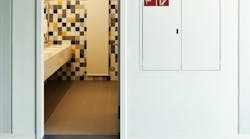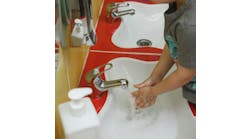It doesn’t take much to persuade students to avoid a school restroom. And too many schools provide plenty of reasons for students to take their bathroom business elsewhere, or hold it in.
Although washroom maintenance and care are not a core part of a school’s education mission, lack of attention to those parts of an education facility can lead to conditions that undermine students’ abilities to perform up to their academic potential. It also can create a negative impression of the school as a whole.
Poor cleaning, inadequately maintained fixtures and equipment, lack of privacy, and insufficient monitoring that allows bullying to occur are some of the circumstances that keep students away from the restrooms in their schools. At best, deciding to avoid school bathrooms distracts students from focusing on their schoolwork; at worst, it can create health problems for them.
Making a greater effort to provide students with safe and clean washrooms can convince students that the facilities can be used without fear and can lead to students’ having a better attitude about the school environment.
A Clean Break
School bathrooms have had a longstanding image problem. In 2011, the San Francisco Youth Empowerment Fund conducted a survey of high school and middle school students in the city’s public schools regarding school restrooms. Asked if they agreed with the statement, “My school’s bathrooms are clean,” only 2.2 percent strongly agreed; 31.2 percent agreed. But 36.7 percent disagreed, and 25.8 percent strongly disagreed.
In some cases, the image of school bathrooms may be inaccurate, and in other cases, the conditions that feed the negative image may be the result of the negligence or outright abuse of the students doing the complaining. Whatever the roots of the problem, the responsibility for eliminating the problems and reversing the image is in the hands of school administrators and their staff members.
Poorly cleaned bathroom fixtures and equipment can result in breeding grounds for bacteria and germs that can create offensive odors, and spread illness and disease among students and staff members.
To combat dirty washrooms, school custodians need to carry out daily cleaning—removing trash, making sure soap and paper towel dispensers are filled and stocking stalls with adequate amounts of toilet paper. Mirrors and glass surfaces should be cleaned, and sinks, countertops, fixtures, door handles and light switches should be disinfected. Urinals and toilets, as well as partitions, should be cleaned and disinfected. Floors should be swept and mopped.
The type of equipment in a school washroom can deter student vandalism and mischief, reduce the spread of germs and expedite cleaning.
Flushing mechanisms, soap and towel dispensers, faucets and doorways can be controlled with sensors so that students can get the material they need without touching surfaces and coming into contact with germs.
Bathroom bullies
Disease and illness are not the only risks to student health in a school restroom. Students can be subject to bullying that can escalate from harassment and intimidation to physical harm.
Schools should acknowledge that bathrooms are likely to be hot spots for bullying and take extra steps to monitor activity there.
“Students may be at higher risk of bullying in settings where there is little or no adult monitoring or supervision, such as bathrooms, playgrounds, and the cafeteria,” says the federal government’s Stopbullying.gov website.
One 2007 study the Web page cites says that 12.2 percent of middle school students reported that they experienced bullying in the bathroom of a school.
In 2012, a survey completed by more than 50,000 teenagers conducted in as part of DoSomething.org’s The Bully Project found that 27 percent of girls and 25 percent of boys reported seeing frequent bullying in school bathrooms. For high school boys, bathroom bullying often escalated.
“There is a strong link between frequent bullying in bathrooms and physical abuse,” says The Bully Project’s report. “High school boys … are over twice as likely to report physical abuse in schools where frequent bathroom bullying occurs.”
More effective than intervention by teachers or other adults is having other students intervene to stop an act of bullying helps reduce violence, The Bully Project says.
“When other students routinely intervene, the probability of frequent bathroom bullying decreases by 10 percent for boys and 6 percent for girls,” the report says. “In short: in areas where teacher and administrators are not typically present (bathrooms and locker rooms), routine student intervention has the greatest impact.”
In addition to encouraging students to step in to stop a bully, schools can provide more consistent adult supervision of bathrooms so that potential bullies become less confident that their behavior will go undetected.
One way to reduce the isolation and lack of supervision is a school restroom is to design the spaces without doors. This enables adult supervisors to monitor sounds in a bathroom even when they choose to remain outside to enhance student privacy.
Some education institutions choose to increase their supervision capabilities by removing doors from toilet stalls to prevent unwanted activity from occurring in those areas.
However, that may raise more trouble for some students who need more privacy than those arrangements afford. The International Paruresis Association estimates that 7 percent of the population suffers from paruresis—the inability to use restroom facilities in the presence of others.
Some privacy advocates have called on schools to install individual bathroom facilities so that students don’t have to be concerned about their privacy or being confronted by bullies.
Sidebar: Transgender students and bathrooms
California Gov. Jerry Brown has signed into law a bill that empowers transgender students to decide which school restrooms to use based on their gender identity.
The law states that “a pupil shall be permitted to … use facilities consistent with his or her gender identity, irrespective of the gender listed on the pupil’s records.”
State Assembly member Tom Ammiano introduced the bill to clarifying existing law that prohibited discrimination against transgender students in public schools. Despite that law, some schools were not allowing transgender students access to some facilities and programs.
Earlier this year, the Arcadia (Calif.) district resolved an investigation by the U.S. Justice Department by promising to take steps to treat a transgender student who identifies as a male in the same way as other male students. The district had been accused of prohibiting the student from having access to restrooms and locker rooms consistent with his male gender identity.
Kennedy is staff writer for AS&U.


